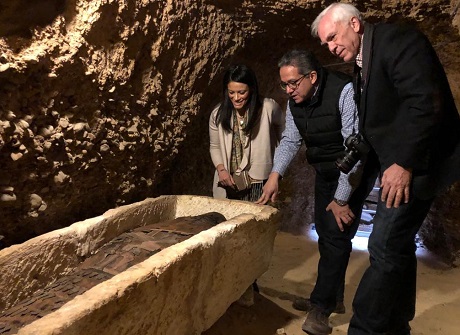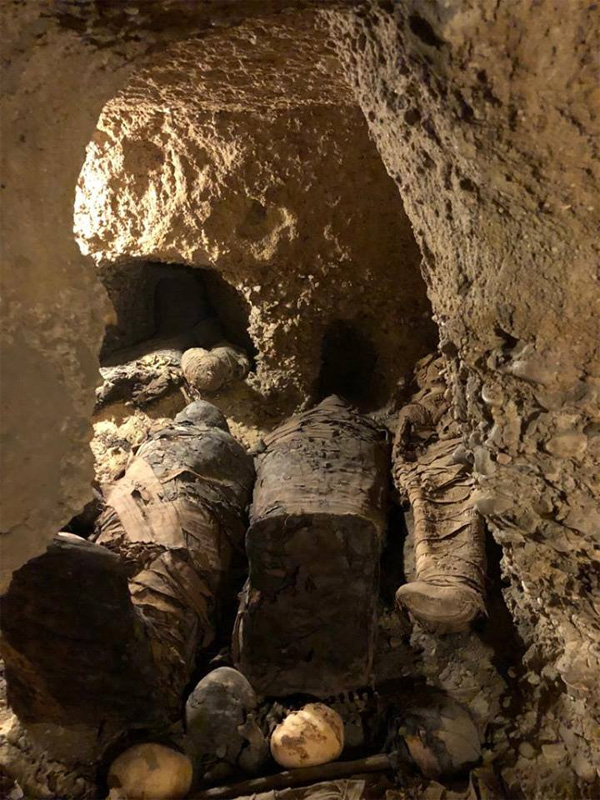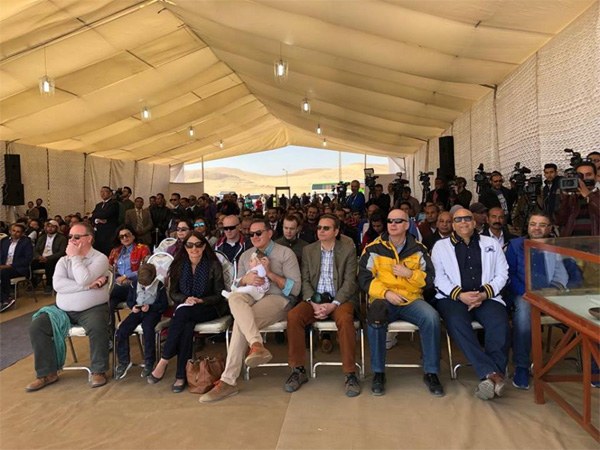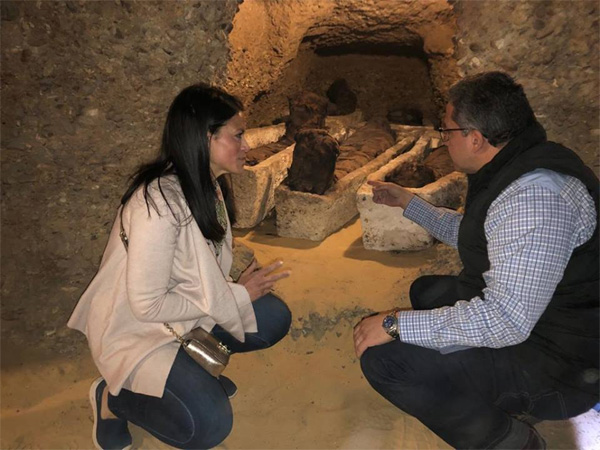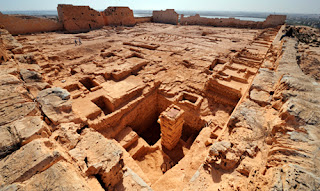Tourist influx hit 11.346 million in 2018, compared with 8.3 million in 2017, according to Saed El-Batouty, Economic Councillor to the World Tourism Organization.
The 37 percent year-on-year increase comes as the result of Egypt’s continuous efforts to revive the tourism sector through the diversification of tours and types of tourism to be enjoyed in the country.
European tourists came on top, with some 6.9 million Europeans visiting Egypt, according to Batouty. Furthermore, 3 million tourists came from Arab countries, whereas about 669,000 were from Asian countries; also, 456,000 visitors headed to Egypt from America and about 166,000 came from African countries.
Interestingly, Batouty pointed out that German visitors to Egypt saw the most increase during the year, recording a stellar 1.7 million tourists.
Egypt has long been known for being a top holiday destination, a fact that has been further supported by articles in CNN Travel, the Independent, The Sun, and the Vancouver Sun in 2019.
All four news sites have ranked Egypt as a top holiday destination during 2019.
CNN Travel
On January 4, 2019, CNN Travel published their annual list of top destinations for the year, placing Egypt in Second place, after Christchurch, New Zealand.
Despite the recent terrorist attack, CNN explains, 2019 will be different.
“So what's different in 2019?” writes CNN.
“Well, while the sand has been settling on deserted classic monuments, Egyptologists have been brushing it gently aside elsewhere to discover a litany of exciting finds, many of which are now being opened to the public,” answers CNN.
As for the safety concerns, CNN writes, “And while safety concerns persist, hundreds of thousands of visitors to the Pyramids of Giza, the Great Sphinx, the Valley of the Kings take place without incident each year. Likewise, Egypt's main Red Sea resorts are considered safe.”
Positively, CNN expects Egypt to receive many more tourists in the run up to its 2020 opening of its Grand Egyptian Museum.
The Independent
Cairo tops the British Independent’s top ten cities to visit in 2019.
Egypt has lots of treasures that are world admired such as the Greatest Egyptian Museum that cost $ one billion, pointed out the Independent.
The Journal further stated that the museum will attach the whole set of Tutankhauman Tomb for the first time.
Cairo is rich with the fabulous Nile cruises and incredible destinations that you have to see.
Matera, the Italian city, ranked second in Independent’s list, which described it as the capital of European culture.
Perth, the Australian city, ranked third, while Lyon, the French city, came in fourth and Chengdu, in China, came fifth.
The Sun
BRITS have shunned Benidorm in favour of alternative destinations such as … Egypt this year,” wrote British news site “The Sun” on January 4, 2019.
The Sun cites Hosbec’s statistics that show that hotels have seen an eight percent fall in British tourists. Instead of heading to Spain, more Brits are not heading towards Egypt and Turkey due to them being cheaper.
“Last year, around 319,000 British nationals visited Egypt,” writes The Sun.
Vancouver Sun
“King Tutankhamun’s complete museum collection — among 100,000 artifacts in total and some of which have never been seen in public — are housed in the newly opened, $1 billion Grand Egyptian Museum (GEM) that overlooks the pyramids of Giza, in greater Cairo,” writes Canada’s Vancouver Sun.
Ranked third on its list, Egypt is actually number one, according to the news site, for tourists who are interested in art, history and ancient life.
“If art, history and the grand scope of ancient life is your balm, this is your happy place,” the news site writes in reference to Egypt.
“Egypt has had its share of travel warnings in the past since the Arab Spring of 2011, but like any metropolis, it is safe as long as you are aware and avoid areas that are off limits, such as the Sinai Peninsula, and don’t wander off into the desert unaccompanied. The GEM is the largest museum in the world dedicated to one civilization. King Tutankhamun’s sandals, more than 3,500 years old, have been restored using special processed developed specifically for this task.”
Egypt’s strategy to attract more tourists
In an interview with Manus Cranny and Tracy Alloway on “Bloomberg Daybreak: Middle East” on November 8, Mashat revealed that Egypt has witnessed a “steep rebound” in the tourism industry, citing the significant increase in the influx of tourists.
Mashat spoke of tourism’s future, its prospects and the work that the government is doing to get the industry back on its feet. She also revealed, “At the end of this month in Parliament, I will be announcing E-Trip: Egypt Reform Program”
Shortly after, Mashat revealed the E-Trip at a Luncheon at the American Chamber of Commerce. The five-pillar strategy is designed to reform and regulate the industry, as well as to ensure its sustainability.
The five pillars start of at an area that has been criticized over and over again by Egyptians and experts, as well as the minister herself: Administrative and legislative reform. Earlier this year, while speaking to more than 10 experts about the problem in the industry, they had all agreed that there is a problem with professionalism and that most workers are not trained well enough to deal with tourists.
Chairman and CEO of Emeco Travel, former head of the Egyptian Tourism Federation and former Chairman of Tourism Chambers Elhamy El-Zayat explains that one of the top priorities in the tourism sector for the next period is training. El-Zayat adds that because there is no language-proficiency requirement for most hospitality-degree admissions, graduates are often left with poor English skills.
He adds that funds do exist to train people working in the sector, indicating that money for training has been allocated ever since former Minister of Tourism Fouad Sultan (1985-1993) was in office. To reach a higher level of service and communicate better with tourists, El-Zayat, Counsellor to the Minister of Tourism Walid El-Batouty and Chairman of the Egyptian Tourism Promotion Board (ETPB) Hisham el-Demery all call for training.
“We need to make sure that people have a good time. Traveling is an experience. You have to make sure that when tourists come, they will find good English, service and information. It is the guide’s role to show the best of Egypt,” says El-Batouty. “Tour guides are in a great position to generate more business for themselves and for the country by showing the best of Egypt. A guide makes it or breaks it.”
In addition to language and technical abilities, Magdy Saleh, the head of the Egyptian Federation of Chambers of Tourism in Hurghada says there’s a need to improve the organization of services offered to tourists. He explains, for instance, that the crowds of taxi drivers at Cairo International Airport’s arrival halls is a chaotic scene for someone stepping out of the airport to be greeted by flocks of drivers shouting randomly at him. “There is need for a policy to organise taxis at the airport better,” he adds. Similarly, Demery would love to see “a global awareness campaign on how to treat tourists.”
Consequently, the minister has taken a positive step forward and moved towards giving people vocational training, educating them to enable them to deal with tourists well, and teaching them proper etiquette for dealing with visitors. The ministry will look to hire more high-quality professionals who are able to manage work. Moreover, vocational training will be given to those who work in the industry.
The second pillar is one that has also been on the forefront of people’s minds over the past two years: Rebranding Egypt. All experts unanimously said that there is an urgent need to maximise the types of tourism programs for an uptick in tourist inflows to occur. “We need to introduce new types of tourism including medical, the Holy Family and MICE [meeting, incentive, conference and events],” Demery told us.
Similarly, Saleh calls for an increase in religious events and festivals to attract tourists. “We have forgotten that Egypt is the land of religions,” he says. “Between Mount Moses, the Holy Family tour, and many other heavenly locations in Egypt, Egypt has the potential to rebrand itself from being [solely] a beach-and-monument destination.”
Batouty explains that we need new ideas, and we need to be updated to revive the tourism sectors, citing two new initiatives that have attracted many guests so far. Run by Art D’Egypte’s founder Nadine Abdel Ghaffar, the first initiative is “Eternal Light. Something Old, Something New,” which took place at the Egyptian Museum, and managed to gain much interest. The exhibition displayed 16 artworks of Egypt’s most prominent contemporary artists, creating a wonderful contrast against the timeless backdrop of artefacts in the museum. Displayed pieces were influenced by ancient Egypt’s art and artists, like Mohamed Abla.
Through social media platforms and social media influencers and bloggers, international tourism campaigns and travel Expos, the tourism is working to rebrand the tourism industry in Egypt as a “responsible choice for eco-friendly tourists” and one that “economically empowers women,” revealed the Tourism Minister.
The third pillar is concerned with fining new markets and diversifying the base from which tourists come to visit Egypt, in addition to beefing up cooperations, focused on tourism, with countries that are considered well-established markets.
The fourth pillar concerns upgrading the hospitability infrastructure. To do so, the Tourism Ministry has decided to launch a private equity find. This fund will also be used to upgrade hotels and resorts that have gone out of style or need to be revamped; an issue that experts we spoke to also brought up.
Concerning this pillar, experts had previously told us that to ensure that the sector keeps growing and accommodate the expected increase in tourist inflows, El-Zayat believes that investors should be allowed to take loans from Egyptian banks. The fact that the door was shut in recent years, he explains, led many investors to downsize their businesses, leaving many unemployed. To maintain the growing tourism sector, investors should be able to rely on banks when needed, El-Zayat suggests.
Calls of increased high-quality investments also came from El-Batouty, who indicates that good investments always make money for Egypt, as well as for the investor. El-Batouty gave Cosmos, an Egypt-based travel company that partners with Viking USA, as a successful model that played a role in tourists’ return to Egypt by providing high-quality services, portraying a positive image of tourism in Egypt.
The fifth, and final pillar, concerns an upgrade to the legislative framework that governs the industry as of right now. This is something that has been on Mashat’s mind for a while: During her first meeting with investors in the tourism sector, Rania El-Mashat, the new minister of tourism, has indicated that she is set on building a newer administrative framework for the sector to allow processes to go smoother and quicker. El-Mashat said that she intends to build a system that would move the sector forward, leading it to be a case study for the international community to take lessons from.
Building on this, Demery told us that there are many great ideas and that people are energetic and enthusiastic to implement them, but to do that, bureaucracy needs to be addressed and the processes need to be upgraded. To keep up with the digital world today, one needs to take actions quicker and keep up with trends, he says, and so we need to be constantly updating our systems to keep up with international trends and needs.
Having spoken to sources who called the industry highly bureaucratic, advising that less bureaucracy would help the industry flourish, it sure is a relief to see the fifth pillar of the strategic plan aim to remove bureaucracy and better the legislative framework. The new framework will be an update to a framework that has not been updated in about 40 years, and will see the ministry itself propose ideas for legislative changes.





